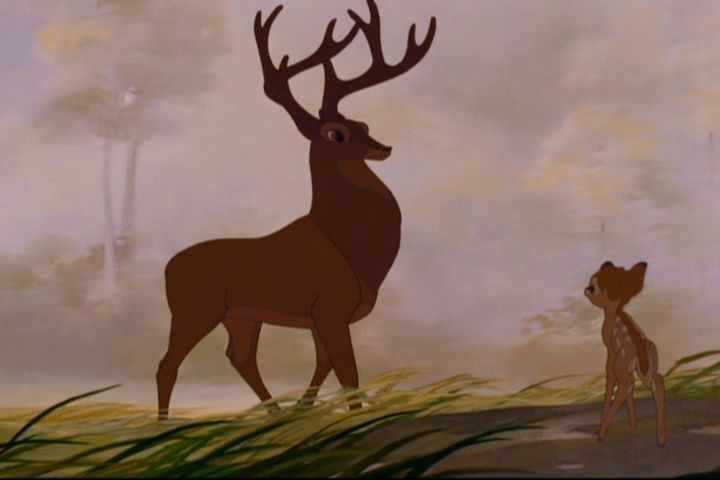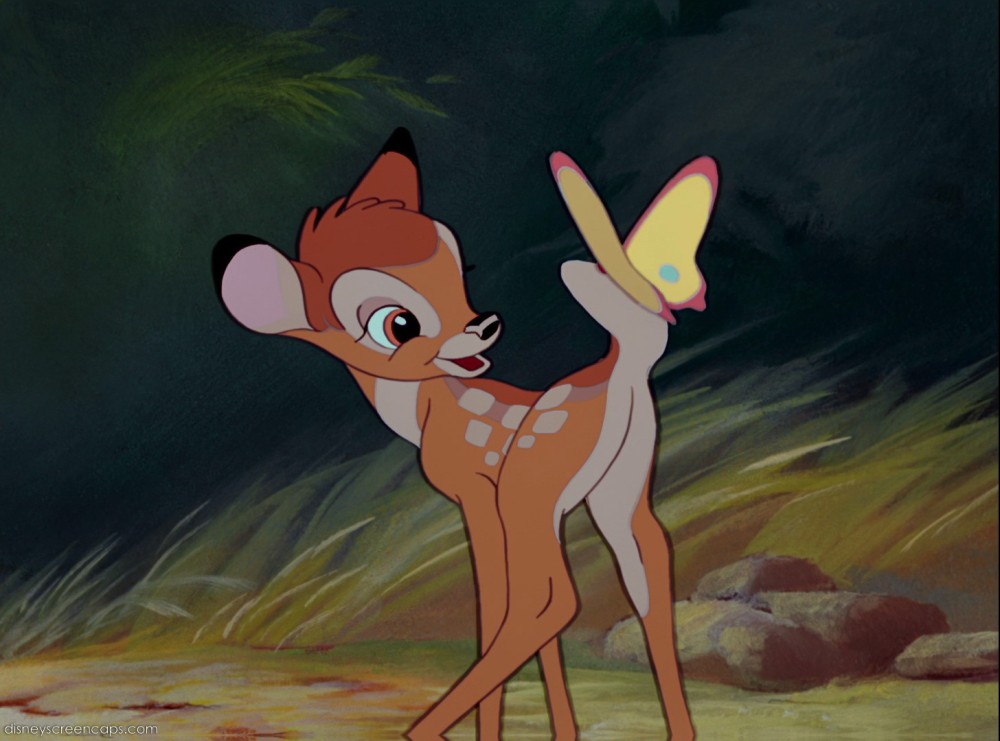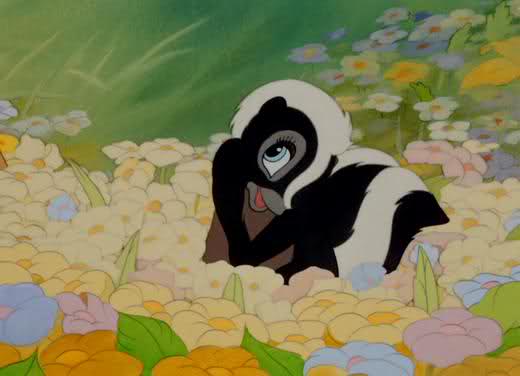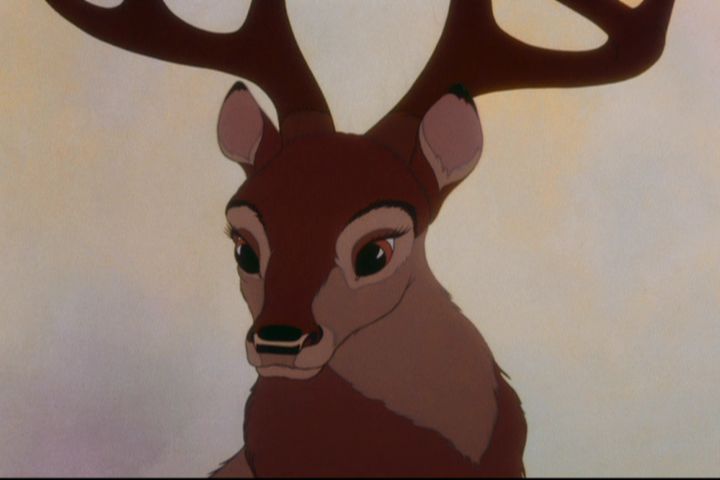First Theatrical Release: August 13, 1942
First Home Viewing Release: September 28, 1989
My Rating: 3.5/5 stars
Where I Found It: My family’s VHS collection — we had the original 1989 release.
Bechdel Test Score: Failed. Because of the abundance of mothers and the implication of sisters, this is one of the few Disney movies that almost achieves gender parity in number of females on screen. Presumably these females, especially Bambi’s and Faline’s mothers, talk to one another — but we never see them talk about anything except Bambi, and most of their speech is directed at their children.
Bambi was the first Disney movie I truly fell in love with, and it was the first Disney VHS my mom bought for me. Up until then, I had existed on a steady diet of repeated rentals and TV specials. For months, I alternated between Bambi and The Land Before Time, watching one or the other every day after school. At the end of 1989, Disney released The Little Mermaid — and Bambi was quickly forgotten as TLM officially kicked off the Disney obsession that would last for a good 10 years.
I don’t think I ever returned to Bambi after The Little Mermaid was released on video, which means it’s probably been about 25 years since I’ve last watched it. Still, I watched it enough back then that many of the sequences were still burned into my memory. I was hoping with my rewatch that I would gain some insight into myself at age 8, or perhaps rediscover why I had once loved this movie so much.
Well … I’m not really sure. In all honesty, I found the movie to be a little slow and was surprised that it held my attention for so many childhood viewings. Perhaps I was drawn to the cute baby animals, or the fact that it could have taken place in the Minnesota woods that were familiar to me. Perhaps I related to the animals in the movie in a way I didn’t to other Disney characters, for although they are “babies,” they really act more like third graders. Perhaps I recognized the dynamics of loving and protective parent-child relationships we see both with Bambi’s and Thumper’s mothers.
But since my reasons for loving it as a child remain mostly shrouded in mystery, I’m left with nothing but my adult impressions.
The Romance of the Absent Father
The idealization of the absent father is probably what struck me the most about Bambi. Bambi  doesn’t seem to know that he even has a father; his mother cares for him completely on her own, and yet she is still awed by the Great Prince when he comes upon the meadow (as are all the animals). He stops and studies Bambi, but this is the extent of his fatherly attention. Still, it leaves Bambi in a sort of awe that the mundane, day-to-day care of his mother can never match. Bambi’s mother tells him that the Great Prince is “very brave, and very wise,” and my first thought was that it was probably a lot easier for him to stay safe when he didn’t have to worry about protecting any of his fawns out on the meadow. (He does “herd” Bambi into the forest when the first hunter arrives and his mother is late to follow, although as the Great Prince of the Forest he probably owes as much to any of the deer.) He doesn’t even acknowledge Bambi as his son until after his mother is dead.
doesn’t seem to know that he even has a father; his mother cares for him completely on her own, and yet she is still awed by the Great Prince when he comes upon the meadow (as are all the animals). He stops and studies Bambi, but this is the extent of his fatherly attention. Still, it leaves Bambi in a sort of awe that the mundane, day-to-day care of his mother can never match. Bambi’s mother tells him that the Great Prince is “very brave, and very wise,” and my first thought was that it was probably a lot easier for him to stay safe when he didn’t have to worry about protecting any of his fawns out on the meadow. (He does “herd” Bambi into the forest when the first hunter arrives and his mother is late to follow, although as the Great Prince of the Forest he probably owes as much to any of the deer.) He doesn’t even acknowledge Bambi as his son until after his mother is dead.
Then we have Thumper’s father, whom we never see but hear quoted by Thumper’s mother, who seems to speak ONLY on his behalf. Apparently he has the privilege of dictating how he wants his family raised, but it’s the mother who has the task of carrying those preferences out in the day-to-day work of parenting. Even as a child I remember wondering where Thumper’s father was — sitting in his burrow with his feet up, a remote control in one paw and a beer in the other?
And for some reason, Flower is apparently raising himself.
Even as I notice these things, it’s hard for me to be too critical of them. Disney was striving to achieve a sense of “naturalism” in Bambi unlike anything that had been done in animation before, and while there are certainly inconsistencies — such as baby bunnies not being afraid of an owl that would chow down on them in the natural world — for the most part it seems the animal’s family relationships mirror what we know about them in the wild. In addition, the audience watching Bambi in its original release had a much different context with which to understand the family than we do now. By 1942, the US had entered World War II, and many children probably were dealing with the reality of absent fathers who were painted in heroic terms by their mothers. Those whose fathers were still at home were probably used to them being more consumed with career than family, and so a somewhat unreachable father loved from afar by both mother and child was probably quite familiar.
Today, about a quarter of all children are being raised without a father. The reasons for this
are myriad, but if the high volume of paternity tests ordered and child support payments abandoned are any indication, in many cases it’s because the father is not stepping up to the plate and taking responsibility as a parent — it is much easier for him to leave, and so he does. How do fatherless children perceive Bambi’s parental relationships today? The Great Prince ends up looking less like a deployed soldier or busy career man and more like just another man who walked out. And I have to admit to feeling quite a bit of disgust when a father merely LOOKING at his son is enough to inspire awe and admiration. (Disney may have attempted to redeem Bambi’s father in 2006 with the release of Bambi II, which I haven’t watched. I hope to do so this week if I have time).
Except for Faline, this trend seems to reverse itself within a generation, as we see both Thumper and Flower as the primary caretakers for their own offspring at the end of the movie.
The Original Story
I read Felix Salten’s Bambi the day before I watched the movie. The book has the same quiet beauty as the movie, and Disney captured the relationship between Bambi and his parents particularly well. Thumper and Flower are missing from the book, which makes it considerably less “cute” and instead much more meditative. Perhaps what surprised me most was the way Disney totally hijacked the overarching theme of the book, which is the importance of learning self-reliance. Near the end, Bambi realizes:
“But of all his teachings this had been the most important; you must live alone, if you wanted to preserve yourself, if you understood existence, if you wanted to attain wisdom, you had to live alone. “
Juxtapose this with the way even adult Bambi frolics with Thumper, Flower, and Faline, as well as the movie’s main theme that “Love is a Song That Never Ends.” (I HATED the music in Bambi as a child, btw, and I didn’t like it any more as an adult.)
And although Bambi took a lot of criticism, especially from hunters, for portraying “man” as the villain, the tension between humans and nature is ratcheted much higher in the book. The Disney movie brushes against this sense of terror most closely in the scene where a quail, panicked by the approach of the hunters, can no longer bear to remain still even though to take flight means her death.
As traumatized as generation upon generation of children is by the death of Bambi’s mother, that same scene is essentially a bloodbath in the book. There’s also a whole story arc in the book about a deer who becomes a pet to a human and is later shot by him, which is far more disturbing than the hunter’s impersonal killing of Bambi’s mother.
So, overall, Disney cut us humans WAY more slack than Salten did. The scenes of man’s approach in the movie are terrifying, and I’ll never forget the score that punctuates it. But to stay totally faithful to the book in this respect may have pushed Bambi into the horror genre.
What About the Kids?
Visually, Bambi really is a beautiful movie, and I think it has important lessons about compassion, growing up, letting go, and change. I find myself wondering if today’s children, who are raised on the Internet and video games, would be as enchanted with repeated viewings of a quiet movie like Bambi as I was. It seems even the ensuing 25 years made me less patient with its more leisurely pace than I would have liked.
For further reading …
- My full review of the book
- How Bambi Broke Disney’s Celluloid Ceiling – a blog post about how Bambi was the first movie to feature a woman in the animation credits; this podcast covers the history of women in Disney animation in more depth.



Great article! Though, I wanted to read the book until you mentioned the bloodbath. I have a hard time reading about animal deaths – they give me nightmares. Oh well, perhaps another time when I’m in a really, really, REALLY good mood and my psyche can handle the book’s darker elements.
LikeLike
Thanks for your comment! I can understand your hesitance to read about animal deaths — they really get to me, too. I can’t handle gore of any type (animal or human) on screen, although I am braver when it comes to reading. The scene in Bambi isn’t so much gory as it is terrifying — it ratchets up the tension and horror in a way that I wasn’t totally expecting or prepared for, more akin to something from Watership Down than Disney. It’s about two and a half pages long, so you could always skip that chapter. 😉
LikeLike
Unlike you, I can never handle deaths of certain animals by humans due to my love for them.
LikeLike